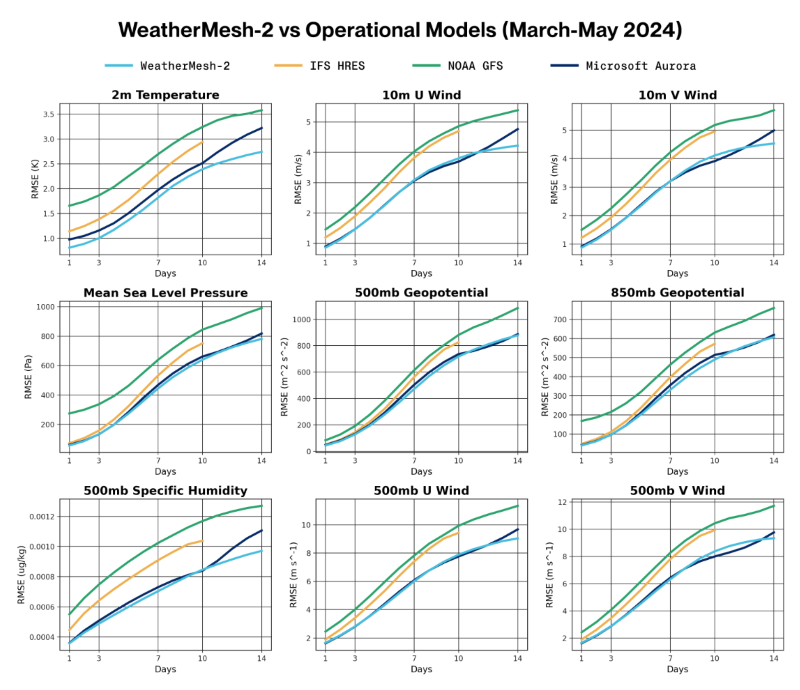Weather forecasting has typically been the domain of national meteorological agencies running physics-based models. Today, that paradigm is being upended by a wave of technological innovation, as AI, satellite mini-constellations, and low-cost sensor networks are reshaping how forecasts are made, who makes them, and who pays for them.
Amid a backdrop of escalating climate risk, extreme weather events, and global policy shifts, the weather forecasting industry is rapidly evolving from a public utility to a complex, privatized, innovation-driven ecosystem. This transformation has far-reaching implications not just for forecasters, but for insurers, energy providers, farmers, governments, and anyone who depends on anticipating the atmosphere.
Why Weather Needs a Tech Makeover
Weather is becoming both more dangerous and less predictable. In 2024 alone, extreme weather events caused over $180B in damages in the U.S., and the ongoing El Niño cycle is projected to sap up to $3T from global GDP by 2029. Traditional forecasting systems struggle to keep up as they are often expensive, slow, and limited in geographic and temporal precision.
Current physics-based models are effective at regional and short-term forecasting, but their accuracy diminishes rapidly beyond 7–10 days, especially for localized or extreme events like flash floods or wildfires. As such, industries and governments are demanding faster, cheaper, and more accurate forecasts. Innovators seem to be answering the call.
AI, Satellites, and Sensors: A New Forecasting Toolkit
A growing wave of start-ups and tech giants are leveraging cutting-edge technologies to revolutionize how we forecast the weather. At the heart of this shift is AI, which enables new models to learn from decades of historical data and generate predictions in seconds, often with higher accuracy and far less computational cost.
Start-ups like Atmo, Brightband, and Silurian are building AI-first forecasting platforms that have outperformed traditional models in speed and precision. Meanwhile, major tech firms like Google DeepMind (GraphCast), Microsoft (Aurora), and NVIDIA (Earth-2) are developing global AI models capable of tracking hurricanes, pressure systems, and even climate-induced variability with remarkable accuracy.
Alongside AI, advances in geospatial technology and low-Earth orbit (LEO) satellites are transforming data collection. Companies like Tomorrow.io and Blue Sky Analytics use their own satellites and environmental intelligence platforms to deliver hyperlocal forecasts, while WindBorne Systems and WeatherXM deploy autonomous balloons and decentralized sensor networks to capture real-time atmospheric data across previously unmonitored regions.

These innovations are commercialized and being adopted across sectors. Energy utilities use them to optimize renewable generation, insurance companies integrate them into risk pricing, and governments deploy them for disaster preparedness.
Who’s Using These Tools — and Who’s Paying?
The value of accurate weather forecasts is no longer just about knowing whether to carry an umbrella. Today, it’s about anticipating and managing systemic risks, from grid instability to agricultural loss to transportation safety.
- Energy companies rely on precise wind and solar forecasts to balance grids and reduce curtailment
- Insurers and reinsurers use high-resolution risk models to underwrite flood, hail, and wildfire coverage
- Farmers, particularly in vulnerable regions like sub-Saharan Africa and South Asia, need seasonal outlooks to plan irrigation and planting cycles
- Military and defense organizations are integrating AI forecasting into logistics and mission planning
- Governments are using new tools to issue earlier, more accurate disaster warnings and allocate resources more effectively
Innovators are monetizing forecasts for these use cases through SaaS APIs, data subscriptions, and enterprise platforms tailored to specific operational needs.
The Surge in Innovation is Not Replacing Incumbents, but Transforming Their Role
National meteorological agencies like the European Centre for Medium-Range Weather Forecasts (ECMWF) and NOAA are now testing and integrating AI models alongside traditional systems. In 2024, the Biden-Harris Administration allocated $7M to NOAA specifically to improve AI-based forecasting, including partnerships with Microsoft and WindBorne Systems.
Big Tech is also blurring the lines between public and private capacity. Google DeepMind’s GraphCast now performs better than many operational models on key forecasting metrics, and Microsoft’s Aurora model was more accurate than ECMWF 92% of the time in 10-day forecasts during 2023.
Meanwhile, insurance incumbents like AXA and Swiss Re, and aerospace giants like Lockheed Martin and Airbus, are either investing in or partnering with weather-tech start-ups to gain competitive advantage.
The Global Picture: Innovation and Urgency Across Regions
While much attention has focused on U.S. and European developments, innovation is accelerating worldwide, often where the need is greatest.
India is seeing rapid growth in climate data start-ups like Blue Sky Analytics, which integrate satellite data and AI for air quality and environmental forecasting. In China, Huawei launched Pangu-Weather, one of the earliest AI models to rival physics-based systems. Pacific Island nations like Tuvalu and the Philippines are working with firms like Atmo to develop sovereign forecasting capabilities using lightweight, energy-efficient AI systems. African and Southeast Asian farmers, underserved by legacy systems, are being targeted by innovators and foundations (e.g., Gates Foundation funding for WindBorne) to close the forecast access gap.
These regions are both climate-vulnerable and data-scarce, making them critical proving grounds for scalable, low-cost forecasting solutions.
What’s Next?
The next frontier in weather innovation will likely focus on integration and scale. Expect to see:
- Broader adoption of AI models by national agencies
- Expansion of IoT-based sensor networks in urban and agricultural regions
- Greater convergence between weather, health, and climate risk platforms
- Policy moves to regulate, standardize, or incentivize data-sharing between public and private sectors
As weather becomes more extreme and less predictable, forecasting will become central to climate resilience, and innovation in this space will no longer be a niche endeavor, but a critical pillar of the resilience ecosystem.

